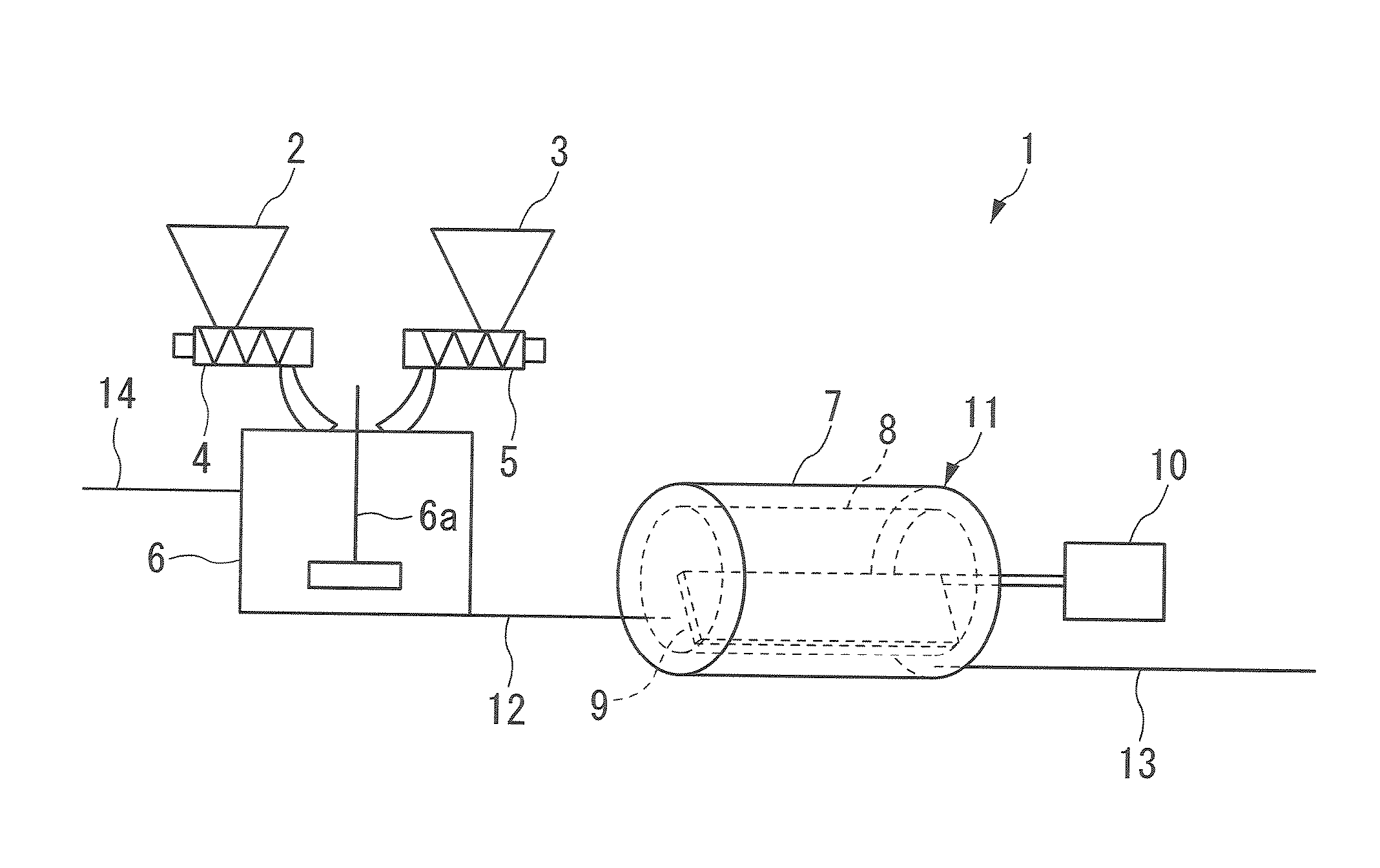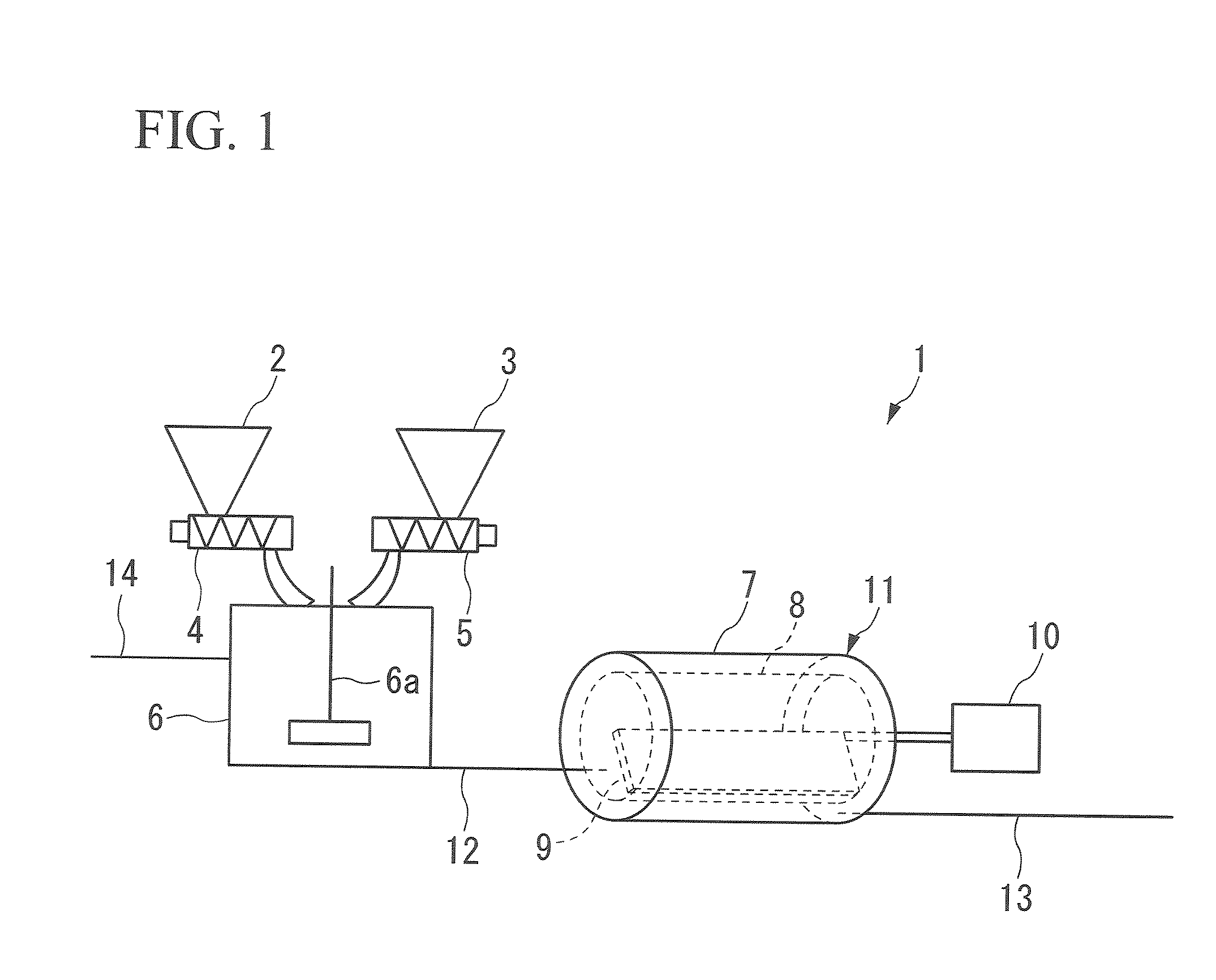Method For Coagulating And Dewatering Sludge With Use Of Polymer Coagulant And Method For Coagulating And Percipitating Waste Water With Use Of Polymer Coagulant
a technology of coagulant and sludge, which is applied in the field of coagulation and dewatering sludge, can solve the problems of difficult adjustment of the type of coagulant, difficult control of the addition amount of the aqueous solution, and the sludge properties change according to the conditions, so as to achieve the effect of reducing the amount of coagulant and reducing the amount of sludg
- Summary
- Abstract
- Description
- Claims
- Application Information
AI Technical Summary
Benefits of technology
Problems solved by technology
Method used
Image
Examples
example 1
[0088] Sludge generated in A treatment plant (oxidation ditch) was treated using a continuous dissolving and feeding device 1 as shown in FIG. 1. As a filter 8, a mesh plate (opening: 100 μm) was used.
[0089] KP7000 manufactured by Dia-Nitrix Co., Ltd. (powdery cationic polymer coagulant (polyamidine-based); cationic equivalent: 6 meq / g; molecular weight: 3,000,000) as a coagulant A, and a powdery amphoteric polymer coagulant (copolymer of acryloyloxyethyl trimethylammonium chloride / acrylamide / acrylic acid=27.0 / 44.0 / 29.0 (mol %); molecular weight: 4,000,000) as a coagulant B were provided in a hopper 2 of the continuous dissolving and feeding device 1, and the following operation was carried out.
[0090] September 24: A powdery polymer coagulant having a blend ratio of 75 / 25 (% by mass)=coagulant A / coagulant B was dissolved in water to prepare 0.2% by mass of an aqueous coagulant solution, the aqueous coagulant solution was added to sludge in an addition amount of 200 mg / L to liquid,...
example 2
[0096] Sludge treatment was carried out in B treatment plant (oxidation ditch) for ten days, using the same device as described in Example 1, and using KP7000 manufactured by Dia-Nitrix Co., Ltd. as a coagulant A, and a powdery amphoteric polymer coagulant (copolymer: methacryloyloxyethyl trimethylammonium chloride / acrylamide / acrylic acid=18.6 / 71.3 / 10.1 (mol %); molecular weight: 4,000,000) as a coagulant B. The sludge treatment was carried out by sequentially changing the blend ratio of coagulant A / coagulant B from 60 / 40 to 70 / 30 to achieve the lowest water content of a dehydration cake. As a result, the average water content of the sludge treated for ten days was 81%.
example 3
[0098] Sludge treatment was carried out in C treatment plant (mixed raw sludge) using the same device as described in Example 1, and using KP201G manufactured by Dia-Nitrix Co., Ltd. (powdery cationic polymer coagulant, methacryloyloxyethyl trimethylammonium chloride 100%) as a coagulant A, and KP7000 manufactured by Dia-Nitrix Co., Ltd. as a coagulant B.
[0099] Regarding the mixed raw sludge having a composition of primary sludge / excess sludge=60 / 40 (mass ratio), when the sludge treatment was carried out using coagulant A / coagulant B=100 / 0, the best result was obtained and the average water content was 78.4%.
[0100] Regarding the mixed raw sludge having a composition of primary sludge / excess sludge=20 / 80 (mass ratio), when the sludge treatment was carried out using coagulant A / coagulant B=75 / 25 (mass ratio), the best result was obtained and the average water content was 79.1%.
PUM
| Property | Measurement | Unit |
|---|---|---|
| retention time | aaaaa | aaaaa |
| particle size | aaaaa | aaaaa |
| particle size | aaaaa | aaaaa |
Abstract
Description
Claims
Application Information
 Login to View More
Login to View More - R&D
- Intellectual Property
- Life Sciences
- Materials
- Tech Scout
- Unparalleled Data Quality
- Higher Quality Content
- 60% Fewer Hallucinations
Browse by: Latest US Patents, China's latest patents, Technical Efficacy Thesaurus, Application Domain, Technology Topic, Popular Technical Reports.
© 2025 PatSnap. All rights reserved.Legal|Privacy policy|Modern Slavery Act Transparency Statement|Sitemap|About US| Contact US: help@patsnap.com


